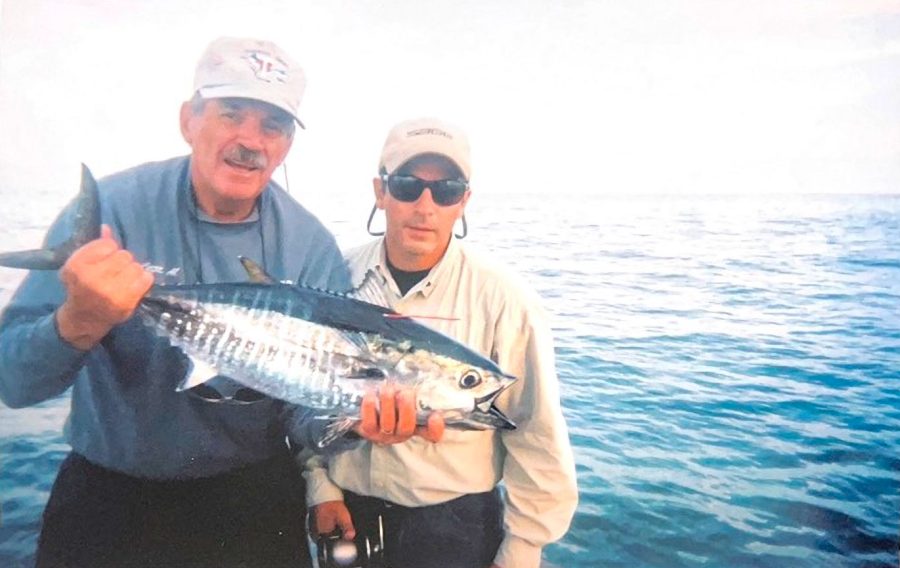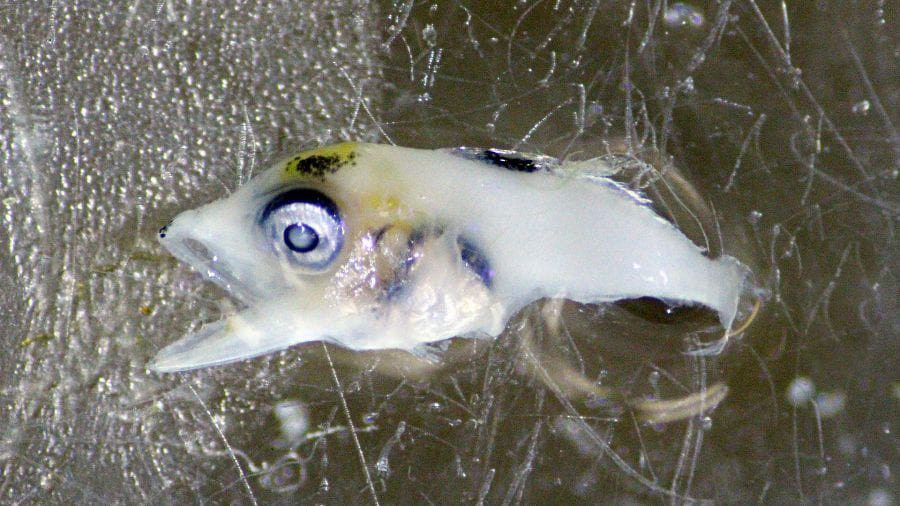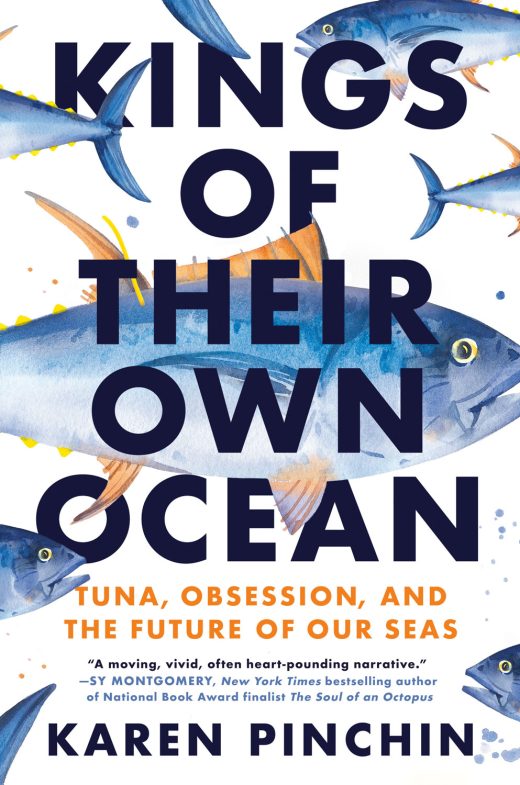Al and Amelia: a Fisherman, a Tag, and a Transatlantic Tuna
Fisherman Al Anderson built an unusual fishing charter business—catch, tag, and release—and one tagged tuna in particular added telling details to the life story of bluefin tuna.
Article body copy
The following excerpt is from writer Karen Pinchin’s book, Kings of Their Own Ocean: Tuna, Obsession, and the Future of Our Seas, in which she delves into the bluefin tuna industry through an interdisciplinary lens—science, business, crime, and environmental justice—and across the world, from Portugal to Japan, New Jersey to Nova Scotia. Pinchin has written on fisheries for Hakai Magazine since 2016, covering oysters and eels, among other marine species.
In this excerpt, we meet fisherman Al Anderson—who caught, tagged, and released more than 60,000 fish over his career—and Amelia, one very special tuna first tagged by Anderson who was caught a remarkable three times and revealed much about the hidden lives of tuna.
Deep below the surface of Rhode Island Sound on September 27, 2004, a bristling school of Atlantic bluefin tuna sliced above an inky‑blue landscape of sandy sea bottom and glacier‑sheared boulders. Brothers swam beside sisters, alongside cousins and distant cousins. They were all only a year or two old, but in the depths off Block Island they were already feared. The warm‑blooded species has a voracious appetite, and the juvenile fish ate nearly everything they came across—shrimp, deep‑water squid, jellyfish—near constantly, and in constant motion, since bluefin must swim to breathe. Their eyes, the sharpest of all the bony fishes’, perceived filtered light from the surface as it dimmed and brightened around them, each night and day like those before.
Within the school, one half‑meter‑long female fish coasted, her pectoral fins splayed like airplane wings that helped her glide and tweak the power generated by her sickled tail. She had small chartreuse‑yellow triangular points running along the top and bottom of her back and belly in matching rows of prehistoric finlets. Her torpedo‑shaped head was smooth, interrupted only by the downward‑curved gash of her mouth and dark eyes. She was one of many, and during her lifetime she would be nicknamed Amelia by a scientist named Molly Lutcavage.
Many months earlier, back when she had hatched and grown into a three‑millimeter‑long larval fish, Amelia’s eyes opened on the warm waters of the Mediterranean. Bluefin tuna spawn only when water reaches between 20 and 29 °C. When they do, they breed in the dead of night, between 2:00 a.m. and 4:00 a.m., producing milky clouds of millions of eggs and sperm that drift five meters below the ocean’s surface. Once fertilized, each egg measures about one millimeter across and will float on balmy currents for one to three days.
Amelia’s first meal after hatching was an oil droplet contained in her own yolk sac. Her tiny body quickly developed huge black eyes and a digestive system, including a disproportionately large, hinged jaw with a toothsome underbite. Over the next two weeks, she grew needle‑sharp teeth, a stomach, and gastric glands to eat and digest crustaceans, including the copepods and water fleas that made up her earliest diet. When she struggled to find food, she ate smaller bluefin larvae to survive. By 25 days old, she had developed a swim bladder and a notochord, or early backbone, and started to swim with other centimeters‑long bluefin her own size. They ate any fish smaller than themselves, evading predators and growing larger, eventually following their species’ annual outward migration westward to the Atlantic’s cold, nutrient‑rich waters.
Sometime between her birth and 2004, Amelia accomplished her first feat of long‑distance swimming, crossing the Atlantic Ocean’s entire breadth before arriving off the coast of western Rhode Island. As she matured, she was on track to beat the odds, becoming one of only two of her fellow 30 million fertilized bluefin tuna eggs to make it to full‑grown adulthood.
As Amelia cruised the waters off Rhode Island, it was a day like any other. But it was also a day for fishing.
A handful of kilometers away, on that same dark, predawn September 2004 morning, Al Anderson’s hulking black truck sped along the paved road that dead‑ended into Narragansett’s Snug Harbor. Its headlights flickered between birch and alder, darkened homes and mailboxes, blurring them into stop‑motion. Al had waved goodbye to his wife, Daryl, who flapped back from their porch with her dish towel, and he couldn’t wait to get fishing. Driving down the steep pitch toward sea level, tall, anvil‑headed Al, with a wiry mass of black hair and his trademark trimmed mustache, parked in a prime pull‑through parking spot beside a drooping tree. He killed the gas and stepped down, eyes scanning the dock for competition, then walked toward his boat, casting lanky floodlight‑lit shadows on the dock’s gray, flaking planks. Dried‑out iridescent scales glinted in the light under his feet, mirroring the fading stars above. There, in prime position near the diesel pump, rocked the 13-meter sportfishing craft Prowler, the third of Al’s boats to bear the name.
That morning, Al had been hired by charter clients to take them out fishing, which he did nearly every day between the spring and late fall when the weather cooperated. This day promised to be a beauty. Al’s mate for the season, Bryan, was already on the boat, and their clients were set to show up at any minute.
Those clients—32‑year‑old Jason Williams and his brother, David, and father, Richard—woke up that morning on musty‑smelling mattresses at a nearby motel. The place was “kind of a dump,” Williams told me, but it was close to the harbor. He had contacted Al by telephone a few weeks earlier after reading an article penned by the longtime charter captain about catching bluefin on a lightweight fly rod. Back then, Williams spent every spare waking moment either going on or planning fly fishing trips, and in the fall of 2004, huge numbers of bluefin had shown up just west of Block Island, powering within a strip of water known as the Race. So Williams took the bait, convincing his father to cover the US $400 deposit and pay Al’s higher‑than‑average $1,350 group fee.
As they got out of their car and headed to the marina in darkness, Williams walked toward the ocean. The wind barely whispered, blowing at less than nine kilometers per hour from the southwest. From the dock, Williams caught a glimpse of Al standing in the Prowler’s wheelhouse. “Go ahead,” Williams told his brother and father, who followed his instructions, striding down onto the pristine white of the Prowler’s deck.

Fisherman Al Anderson led catch, tag, and release bluefin tuna charters on his boat, the Prowler. Photo courtesy of Daryl Anderson
Descending from his perch, Al moved toward them, his arms spread wide. Williams immediately knew they weren’t being welcomed. Instead, they were being pushed off the boat. “He hadn’t invited us on yet. He just came walking at us and shoved us back off,” said Williams. “It wasn’t like, Good morning. It was like, All right, you guys get off the boat, and I’ll tell you when to get on the boat.” Walking backward, the shocked fly fisherman thought, “Holy shit. This is going to be a long day.” The moment hung in the air, the three clients standing awkwardly on the planks. A beat passed. Then another beat, and as if nothing had happened, Al smiled and genially waved the group aboard.
Less than an hour after leaving the harbor, they arrived at that day’s fishing grounds, a popular spot called the Mud Hole. Al motored until he found a spot he liked, looking for fish on his sonar and carefully analyzing the currents that pushed around them. Once floating atop a patch he felt good about, Al killed the big engines, allowing the boat to drift as he and Bryan double‑checked their rods and lines. That day, in addition to Williams fly fishing with his own gear, the group fished from standard rods and reels spooled with green monofilament, a single extruded nylon strand Al favored for its strength and near transparency underwater.
The lines’ ends were tied with 113-gram diamond jigs, each with an elongated bullet shape and four light‑catching sides with a hook on the end. “Diamonds” have been handcrafted by enterprising fishermen for more than a century; they are simply dropped into the water, where they fall vertically, flashing like a small fish when pulled behind a drifting boat or reeled in. They’re often used to catch black sea bass and bluefish. Here he was, chuckled Williams to himself, trying to land a mighty marine predator with a rod a kid could lift and tackle he could buy at any basic tackle shop.
First, Al needed to let the tuna know where they were. To do that, he and Bryan chummed the water, dumping chunks of creamy‑fleshed butterfish behind the boat. Within moments of their first line hitting the water, the Williams men started pulling at strikes on their rods, hauling juvenile bluefin tuna into the boat by the dozens, feeling the adrenaline hit as they hauled on the reels over and over again. They couldn’t believe their luck. The one‑ and two‑year‑old fish hanging from their hooks were nicknamed “footballs” for their prolate spheroid shape and size but were denser than they looked and fought hard. Williams savored every second of the action. He felt the tips of the rods jerk in his hands with every strike, bracing his feet and stomach, sensing tension on the line as he fought each fish. The reel spun every time it ran from the boat, his rod tip bending like a weighted willow branch toward the water.
During his first phone conversation with Williams, Al had made himself clear: unlike most charter clients, their group would keep only one fish. Even if they could legally keep more, if it were up to Al, they would catch as many as they could and then tag and release them all. To be sure, most clients returned with wet bagfuls of fish to feed families and friends, to brag about at backyard barbecues over beers. But what Al really wanted to do out on the water was to mark as many fish as possible with tiny bits of numbered plastic, set those fish free, and wait for the data to flow in. And that particular day was on track to be one of his greatest yet for tuna tagging.
Two years earlier, Al had re‑caught a bluefin tuna he had previously tagged himself, an experience that fanned the flames of his obsession. Daryl recorded the moment in Al’s tidy annual logbook, a lined dossier with a black‑and‑white mottled cover and pages that crackled with ink running from margin to margin. With every year he fished, those logbooks piled up, their spines and contents bulging with successes and failures. Since his first days of tagging fish, Al once wrote in an unpublished memoir, he had long hoped to beat the extremely slim odds that he, a single fisherman, could catch the same fish twice.

Anderson, his fishing charter client Jason Williams, and Amelia, the bluefin tuna that Anderson first tagged. Photo courtesy of Daryl Anderson
“How naive I was!” he wrote in 2018 of those early hopes, wryly noting that it “only” took 36 years of bluefin tagging for it to happen. On the occasion, officials at the National Marine Fisheries Service told him only a dedicated tagger could ever hope to recapture a bluefin they themselves had marked before. “The simple satisfaction of recycling this particular fish makes all the effort over the years worthwhile,” he said. “You can’t imagine how good that feels.” Accomplishing a feat that few anglers could fulfilled a primal need in Al; he wanted to feel remarkable, and to know that through hard work, preparation, and grit he could accomplish something extraordinary.
Adapted from Kings of Their Own Ocean: Tuna, Obsession, and the Future of Our Seas by Karen Pinchin, published July 18, 2023, by Dutton, an imprint of the Penguin Publishing Group, a division of Penguin Random House. Copyright © 2023 by Karen Pinchin.



